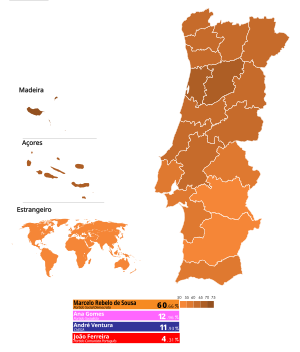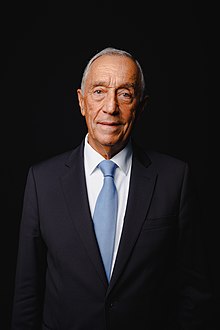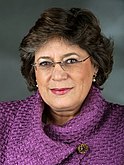| |||||||||||||||||||||
| Opinion polls | |||||||||||||||||||||
| Registered | 10,847,434 ( | ||||||||||||||||||||
|---|---|---|---|---|---|---|---|---|---|---|---|---|---|---|---|---|---|---|---|---|---|
| Turnout | 39.26% ( | ||||||||||||||||||||
| |||||||||||||||||||||
 Results by district | |||||||||||||||||||||
| |||||||||||||||||||||
Presidential elections were held in Portugal on 24 January.[1] The incumbent President, Marcelo Rebelo de Sousa, was reelected for a second term.
The elections were held during the COVID-19 pandemic, and Portugal was under a lockdown as of election day.[2] President Marcelo Rebelo de Sousa was reelected by a landslide, winning 60.7 percent of the votes.[3] He won every district in the country and all 308 municipalities, a result which happened for the first time ever in Portuguese democracy; he won 3,083 parishes out of 3,092.[4] The election also marked the rise of right-wing candidate André Ventura, leader of CHEGA, who polled 3rd with almost 12 percent of the votes.[5] In second place, former MEP and Ambassador Ana Gomes was able to win 13 percent of the votes, the best result ever for a female candidate in a presidential election.[6] The rest of candidates did not receive above 5 percent each.
Voter turnout fell to 39 percent, a drop of nine percentage points, mainly due to the automatic registration of overseas voters; this practice increased the number of registered voters to almost 11 million.[7] In Portugal alone, turnout stood at 45.45 percent, a decrease of 4.6 percentage points when compared to the 2016 election. This was the lowest drop in turnout in an election with an incumbent running since 1980.[8]
Cite error: There are <ref group=lower-alpha> tags or {{efn}} templates on this page, but the references will not show without a {{reflist|group=lower-alpha}} template or {{notelist}} template (see the help page).
- ^ "O Presidente da República, Marcelo Rebelo de Sousa, marcou hoje as eleições presidenciais para 24 de janeiro de 2021". www.24.sapo.pt (in Portuguese). Sapo. Retrieved 24 November 2020.
- ^ "Portugal holds presidential election as COVID-19 cases spiral". Reuters. 23 January 2021.
- ^ "President Rebelo de Sousa wins landslide reelection in Portugal". Politico. 24 January 2021.
- ^ "As nove freguesias — em 3.092 — onde Marcelo não ganhou". Observador. 25 January 2021.
- ^ "Marcelo dominou, Ana Gomes foi 2.ª mas Ventura venceu mais distritos. Esquerda caiu a pique". SIC Notícias. 25 January 2021.
- ^ "Presidenciais: Ana Gomes é a mulher mais votada de sempre". Público. 24 January 2021.
- ^ "Recenseamento automático de emigrantes fez subir abstenção seis pontos". TSF Radio. 25 January 2021.
- ^ "Sem eleitores no estrangeiros, abstenção foi de 54,46%". Público. 26 January 2021.


